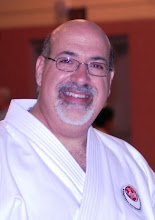 THE FOUR CORNERSTONES
THE FOUR CORNERSTONESThe building blocks of karate
As with anything of substance Shotokan karate is based upon a strong foundation.
Like a forty-two story office building standing tall and proud, Shotokan karate is supported by four cornerstones without which it could not have stood the test of time. These four building blocks are: a proper stance, proper posture, proper balance and proper "kime" or focus.
Without these four basic building blocks working in harmony with each other, equally weighted, and equally given their due, you will never learn to develop your techniques to their full potential, and thus you will never have any hope of truly understanding let alone mastering, the art of Shotokan karate.
STANCE
Your stance is the platform upon which everything else is built.
It is the beginning, middle, and end of all that you will do as a Shotokan karate-ka. More than any other style of karate Shotokan is noted for it’s long low stances which, when practiced correctly, are very effective at creating a low centre of gravity, promoting good stability, and fostering strong muscular development.
Early on in your karate training you will quickly be made aware of the fact that landing in a poor stance, however momentarily, will create a level of instability that will prevent you from making any effective defensive or offensive movements, while at the same time you will be leaving yourself open to a successfully attack or counter attack from your opponent.
Given such an opening even a junior belt properly trained will seize upon the moment and may be virtually assured of victory due to your lack of stability and strength.
Without a proper stance nothing else is possible.
POSTURE
Your posture says it all.
From walking down the street, to sitting in a business meeting, or simply driving in your car. In your daily life how you carry yourself says a lot about who you are. Throughout our early childhood we were all told to sit up straight, to stand up properly, to keep our head up, and to watch where we were going. Today how you personally hold yourself, how you carry yourself when you move, and how you focus on your surroundings, depends largely on how well you have taken these early lessons to heart.
In Shotokan karate it is vital that you learn to always center your torso over your hips when you move. If you can remain conscious of this fact, especially when shifting from one stance to another, then by combining good hip movement with proper posture and balance you will create a strong vertical center, thus making smooth rapid movements possible and effective.
The hips should be considered the steering wheel of your body.
You will quickly come to learn that poor posture equates to poor everything else.
BALANCE
Good balance is the result of a proper thought.
In karate from the moment you start to move from one stance to another, or from one technique to another, you are essentially risking all that you have in the hope of achieving something better. This period of transition often lasts for less than a split second of time, a time in which balance plays the role of the sun, acting as the center of your universe around which all of your other actions must revolve. Without proper balance a successful out come in anything karate related is virtually impossible.
Balance, however, can never be achieved unless the scales are even. While your technique and skill will weigh heavily on one side of the scale, they must in turn be equally balanced by the mental and spiritual side of your being. In karate trying to perform any movement or technique requires a level playing field, one in which each function must be awarded just the right amount of concentrated effort necessary to make the whole thing work as you intended it to.
Balance is the sum of all movement added together.
Only when the body, mind, and spirit are in complete harmony can proper balance be achieved.
KIME
Kime is the sum of all your efforts.
The concentrated focus of all your physical, mental, and spiritual actions combined at a specific moment and place in time is called kime. The moment you make any kind of movement in karate your true level of kime will be reflected in the accuracy and quality of your techniques and any errors in judgement will then be clearly visible for everyone else to see. If your kime is found lacking then in effect nothing you just did should be considered real. No amount of strength, no amount of speed, and no amount of kiai can ever make up for a lack of kime.
In your training you must believe in what you are doing, and that belief must have a definitive beginning and ending, an ending that you will find you can only reach by putting all of your other thoughts aside and focusing for as long as it takes to achieve your goal. Without this all encompassing belief in the success of what you are attempting to do your techniques will become nothing more than physical actions without any mental substance, in a world where mental substance is often the difference between victory or defeat.
Without kime your karate has no value.
Kime is only effective when nothing else matters.
So there you have it, the four basic fundamentals without which your karate will not develop properly.
So train hard, train often, and make these fundamentals the basis for everything you do in the dojo.
Remember - Stance, posture, balance, and kime,
are the foundation upon which you must build.




